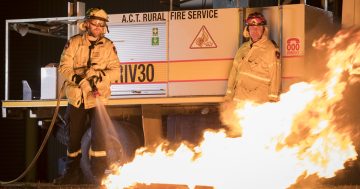
The Orroral Valley was still severely damaged at the start of this year, almost 12 months after the devastating bushfire. Photo: ACT Parks and Conservation Service.
Above-average rainfall and close to average daytime temperatures with warmer nights throughout Spring are expected to bring some reprieve for ACT emergency services with a below-normal fire risk in forest areas.
The added moisture and residual damage from the Orroral Valley fire have decreased the risk associated with fuel loads like deadwood after it burned 78 per cent of Namadgi National Park and 22 per cent of the Tidbinbilla Nature Reserve.
However, the fire risk in the ACT is higher in grassland areas due to the wetter winter. These conditions are expected to continue with an extremely high chance the Territory will be doused with more rain than usual in the lead up to Summer.
The outlook, compiled by the Australasian Fire and Emergency Services Authorities Council’s (AFAC), the national council for fire and emergency services, said that fire agencies and land managers would continue undertaking prescribed burning when the conditions allow.

The Spring bushfire outlook. Photo: AFAC.
The surrounding region will similarly be in for below-average fire risk, with favourable forecasts for areas south of Sydney which are due to record above-median rainfall and experience a delayed start to the fire season, according to the AFAC outlook.
“However, this rainfall and warmer Spring growth may see grass and crop fuel loads build during this period,” it said.
According to the Bureau of Meteorology, the wetter conditions are being driven by the negative Indian Ocean Dipole (IOD), which refers to the “sustained changes in the difference between sea surface temperatures of the tropical western and eastern Indian Ocean”.
A negative IOD increases the change of rain across Spring for a significant part of southern and eastern Australia, especially in the southeast.
However, the ACT Emergency Services Agency is yet to advise on an official start to this year’s bushfire season, but they have reminded Canberrans that having a survival plan is still necessary.
“The ACT ESA would like to remind the ACT community that we are entering the storm season, and despite the bushfire outlook having a below-normal potential for forest fires, residents should review or develop a survival plan and prepare their properties,” a spokesperson said.
“Storms and fires may occur at any time, so it is important to know what you will do in the event you are impacted.”
The conditions will coincide with one of the ACT’s worst-ever pollen seasons, likely brought on by the combination of warming weather and a wet winter with high soil moisture.
Canberra has already had two extreme pollen events on 12 and 16 August, and while elevated levels are not uncommon at this time of year, extreme events are unusual and indicate a bad few months ahead for allergy sufferers in the capital.



















